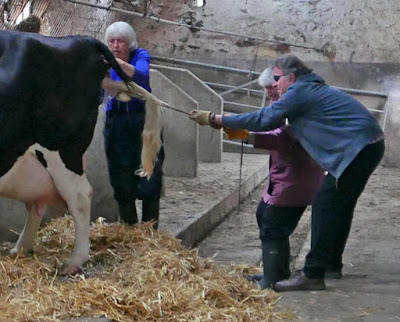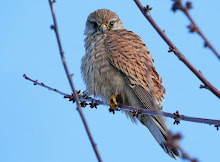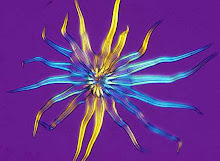Thursday, July 28, 2016
Delivering a calf
We've known Maureen and Barbara, who run a farm near us, for over 40 years. Maureen is recovering from a broken shoulder (boisterous cattle!) so they needed some extra help to deliver a calf this afternoon.
It takes a lot of effort to pull the calf out during the final stages of birth .....
.... especially when mum lays down.
The new arrival .....
... carried in a big plastic bag to a deep bed of straw in its own stall
It's a bull! They've promised to call it Phil ...
Mum looking very calm after the birth (she has done this before!)
Drying the calf with a towel ....
... then a first drink of milk ....
Here are a couple of older half-brothers, about 10 days old
A memorable afternoon
Labels:
cattle
Tuesday, July 26, 2016
Solitary bee, just hanging around
Every afternoon for the last three days this little solitary bee has been hanging from the same grass floret in our garden, gripping with its jaws. Occasionally it flies over to a lamb's ear Stachys byzantina plant to feed on the flowers, then it returns to exactly the same spot.
Update
I now know it's a fork-tailed flower bee Anthophora furcata
Thanks to the following on twitter, who all agreed on the ID
Africa Gomez @aBugBlog
Bumblebee etc. @wurflenii
Barry @scyrene
The wonderfully helpful naturalist community on Twitter are superb when you need ID help. They came up with the answer within 15 minutes of posting.
One of the interesting things about this species is that it nests in rotten tree stumps and we have several of those in the garden, with some few sawdust where something has been tunnelling into them. I'm hoping it it might be fork-tailed flower bees
Friday, July 22, 2016
Salty tales of Strand-line Plants
These are three different species that we saw recently in Northumberland which belong to a select group plants that colonise the strandline on the seashore. They live in that narrow zone just above the extreme high water mark, usually marked by a line of dry seaweed. It is hard to imagine a more demanding environment; it's dry, salty, and often hot and windy, so the plants are often blasted by wind-blown sand.
This is sea rocket Cakile maritima, the most attractive of the three strandline specialists that we found. It's a member of the cabbage family and is an annual species, germinating in spring and quickly putting down deep roots into damp sand below the surface.
Sea rocket seed pods are corky and water resistant, acting like lifeboats that can carry seeds long distances in safety on ocean currents. A species of sea rocket was the first higher plant to appear on the volcanic island of Surtsey in 1965, just two years after the island appeared above the waves.
Sea rocket's mauve flowers are attractive to bees and cabbage white butterflies.
Dealing with salt in the moisture around it's roots is a challenge and it manages this by sequestering the salt in vacuoles in its succulent leaves.
Frosted orache Atriplex laciniata, another annual, has a different way of dealing with the salt, by pumping it into glands on the leaf surface.
It forms extensive stands along the strandline and ......
... the leaves develop this grey appearance.
This is due to a coating of swollen hairs, seen here under the microscope, where salty water accumulates and then crystalises.
The dense covering of salt-laden hairs is highly reflective and as they die that either fall off or are washed away by rain, ridding the plant of toxic salt.
In this vertical section through an Atriplex leaf, magnified under the microscope, you can see the swollen hairs on both sides of the leaf surface, separated by the green photosynthetic tissue of the leaf itself.
Finally this is prickly saltwort Salsola kali, a tough annual that could ruin your picnic if you happen to sit on it because the leaf tips carry short but sharp spines. The minute white flowers are carried in the axils of the upper leaves.
Here the plant is growing just above the strand line below Alnmouth dunes.
These plants show another hazard that these strandline plants face - constant burial by trapped particles of wind-blown sand. Maybe that's why the flowers are produced at the shoot tips.
This is sea rocket Cakile maritima, the most attractive of the three strandline specialists that we found. It's a member of the cabbage family and is an annual species, germinating in spring and quickly putting down deep roots into damp sand below the surface.
Sea rocket seed pods are corky and water resistant, acting like lifeboats that can carry seeds long distances in safety on ocean currents. A species of sea rocket was the first higher plant to appear on the volcanic island of Surtsey in 1965, just two years after the island appeared above the waves.
Sea rocket's mauve flowers are attractive to bees and cabbage white butterflies.
Dealing with salt in the moisture around it's roots is a challenge and it manages this by sequestering the salt in vacuoles in its succulent leaves.
Frosted orache Atriplex laciniata, another annual, has a different way of dealing with the salt, by pumping it into glands on the leaf surface.
It forms extensive stands along the strandline and ......
... the leaves develop this grey appearance.
This is due to a coating of swollen hairs, seen here under the microscope, where salty water accumulates and then crystalises.
The dense covering of salt-laden hairs is highly reflective and as they die that either fall off or are washed away by rain, ridding the plant of toxic salt.
In this vertical section through an Atriplex leaf, magnified under the microscope, you can see the swollen hairs on both sides of the leaf surface, separated by the green photosynthetic tissue of the leaf itself.
Finally this is prickly saltwort Salsola kali, a tough annual that could ruin your picnic if you happen to sit on it because the leaf tips carry short but sharp spines. The minute white flowers are carried in the axils of the upper leaves.
Here the plant is growing just above the strand line below Alnmouth dunes.
These plants show another hazard that these strandline plants face - constant burial by trapped particles of wind-blown sand. Maybe that's why the flowers are produced at the shoot tips.
Sunday, July 17, 2016
Small skipper
I find large and small skipper butterflies hard to tell apart but I'm pretty sure this is a small skipper Thymelicus sylvestris, feeding on marjoram at Stanhope in Weardale.
Skipper butterflies have a very distinctive way of holding their wings, half-open, that separates them from all other British butterflies and from moths.
When I first came to live in the North Pennines in the 1970s small skippers were unknown here but since then they have gradually colonised the area and their range now extends well into Northumberland; a butterfly good news story.
Labels:
butterflies,
marjoram,
small skipper,
Thymelicus sylvestris
Thursday, July 14, 2016
Gold-ringed dragonfly
We found this magnificent male gold-ringed dragonfly Cordulegaster boltonii beside the river Derwent near Blanchland in Northumberland last week.
This was an unusually cooperative insect, allowing me to get very close. I suspect that it had only recently emerged from its nymphal stage. It flew briefly, then settled down again to sunbathe.
The female gold-ringed dragonfly has the longest body of any British dragonfly species; males are a little shorter and have a slightly clubbed tail, but are nevertheless spectacular insects.
Tuesday, July 12, 2016
Longhorn beetle Strangalia maculata
It's the season for hogweed flowers, which brings with it a host of interesting insects that either feed on its pollen and nectar or hunt other insects on those flat umbels of tiny flowers.
There's also an added bonus for the ageing naturalist because hogweed inflorescences are mostly held aloft on 4-5 foot tall stems. It's so often the case with macrophotography that you either need to crouch down or get down on your hands and knees to take photos. My ageing knees make that increasingly painful but when they're feeding on hogweed insects present themselves conveniently at head-height.
This rather beautiful longhorn beetle is the one that I've always known as Strangalia maculata but which is now called Rutpela maculata. It seems to particularly favour hogweed flowers.
Each individual flower in a hogweed umbel only produces a very small volume of nectar but insects can crawl over them to collect it without expending much energy, so even though each individual reward is tiny there's ample net energy reward for less energetic insect species like this colourful beetle.
Hogweed umbels also provide a convenient mating platform .... thanks to bison (see comment below) for identifying these two longhorns, photographed in Weardale a day after those above: 'The pair enjoying a romantic moment in the final picture look like Pachytodes (or Judolia) cerambyciformis. I'm looking at the all-dark antennae & legs, and the pinkish-brown colour of the elytra.'
You can see the elytra patterns a little better from this angle and I'm wondering now whether this is Judolia sexmaculata, the three-banded longhorn beetle, which according to some sources is a nationally scarce species......
Monday, July 11, 2016
Feedling time for swallow fledglings
We spent a delightful half hour this afternoon watching swallows feed this brood of eight fledglings. They were perched on some dead branches on the far side of a hedge and were unconcerned by our presence.
Swallows become infested with fleas and lice in the close confines of their nest and these youngsters spent the intervals between feeding either preening or fluffing up their feathers to cool off on a very warm afternoon.
It seemed to be the case that the fledglings that had chosen the highest perches were visited with food more often.
Labels:
swallows
Subscribe to:
Posts (Atom)





















































































